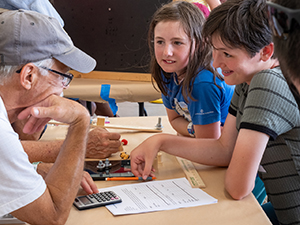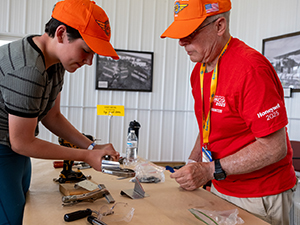An afternoon volunteering at the Vintage Aircraft Association’s Charles W. Harris Youth Aviation Center at EAA AirVenture Oshkosh

In every General Aviation (GA) group I’ve worked with, people discuss with great urgency how to get more young people involved in aviation. EAA chapters often focus on youth building projects and Young Eagles flights, museums offer summer camps and activities, and many pilots take it upon themselves to share the love of flight wherever they can. It all helps – you never know what might spark interest for a kid.
At EAA AirVenture 2025, I enjoyed an afternoon volunteering at the Vintage Aircraft Association’s Charles W. Harris Youth Aviation Center. It’s a new building — a spiffy hangar opened in 2024 specifically for kids’ activities, located on the edge of the vintage area near Theater In The Woods. Welcoming and bright, each day during AirVenture, volunteers work with kids on a wide array of activities that relate directly to flight science, mechanics, building, and more.
There is not a screen or computer in sight in the hangar. In an age when most kids have a phone or tablet of their own, the novelty of working with real tools and making real things is a big draw for kids and parents alike.
I spent two hours working at the airfoil-making station. Using a simple paper printed template, I guided kids to cut, tape, and punch holes, creating an airfoil that could then be tested out on a wire in front of a fan. The younger kids sometimes needed help with the hole punch and just marveled at the “magic” way their airfoil floated in the airstream; older kids asked more questions, and I would chat with them about how the air moves over the wing, and why the upper surface was longer than the bottom surface. One kid asked, “But what happens if I put it in the airstream upside down?” I said, “Try and find out!” Learning often looks like playing.
My favorite station was the “weight and balance” activity. As a student pilot who is not gifted at math, weight and balance calculations have been one of the more challenging parts of my training. Visualizing the problem and using a digital simulation helped somewhat, but honestly, it was using the simple ruler, fulcrum, and passenger/pilot/luggage weights in this kids’ activity that made the whole concept “click” for me. With a simple worksheet showing where to write the numbers, and using an actual ruler as the aircraft – thus providing the measurement numbers for the arm printed right on the ruler – the equation finally made more sense. After calculating the correct fulcrum, putting the ruler on that number and seeing it balance felt a little bit magical!
Another activity allowed kids to use hammers, wood, nails, and glue to construct a little toolbox to take home. The constant hammering sounds made the room a bit loud, but the looks of satisfaction on the kids’ faces, and their joy at creating something so useful and real, were priceless! Many children nowadays have no experience with tools, and have never used a hammer or screwdriver before, so being “let loose” to experiment, try, fail, learn, and always succeed makes an impression that can last a lifetime.

In a quieter activity, kids used basic fasteners – a bolt, washers, and various nuts – to make a little cowboy figure on a keychain. Might sound a little silly, sure, but especially for younger kids, simply becoming familiar with nuts and bolts was a new experience, and being able to take home something they made themselves was a confidence booster.
Other activities included making flyable foam gliders out of Styrofoam plates, wiring a simple electrical circuit to make a light turn on, swaging, bending sheet metal to make a handy phone stand, testing out various fasteners and the tools that move them, and sorting tools by size.
Volunteers of all ages and aviation experiences assisted, two at each station. The hangar was packed full of kids and parents for the whole two-hour activity window.
In addition to daily afternoon workshop sessions, this year the Charles Harris team also hosted two teen nights, and an afternoon workshop session specifically for special-needs children.
AirVenture can be overwhelming, and similarly, so can getting involved in aviation. There are so many focus areas, so many opportunities, so many extracurriculars for every age. The Charles W. Harris Youth Aviation Center does an amazing job offering many activities suitable for a wide range of ages, making it all welcoming and accessible, and providing a glimpse into the myriad different areas of aviation that kids can explore – all without being too overwhelming.
It’s easy to say, “We need more youth in aviation,” and kid workshops like that at the Charles W. Harris Youth Aviation Center and at local EAA chapters, can be our first steps as volunteers.
After that afternoon, I took these four main concepts back with me to influence our youth activities at the Kelch Aviation Museum:
- Real things are real-ly cool. A real tool, or working with real material, is way more compelling for most kids than an audio-visual screen or a lecture. Especially for children with lower attention spans or trouble focusing, being able to use their hands and actually create or use something is a game-changer.
- Use what you have! The tools in your toolbox, simple bolts leftover from a project, or good old paper and scissors: These are all perfect for creating fun, educational activities for kids. You don’t need anything new, expensive, or fancy – think about what’s useful, what you use every day, or what kids might have questions about.
- Showcase more aviation careers than simply becoming a “pilot.” Mechanics, engineers, flight instructors, fixed base operators, aircraft manufacturers, airport managers, air traffic controllers, aviation historians, and even creative/artistic professionals like me, are all needed in the aviation world, and kids can be inspired to try something new.
- Let kids figure stuff out for themselves. It’s ok to struggle a little – that makes the end product more rewarding. If you can make a project safe, appealing, but still suitably challenging, kids will be more invested. Overcoming a challenge makes a bigger impact than breezing through a simple task.
Yes, we need more young people in aviation. Luckily, aviation itself is exciting enough to attract them… We just have to make sure newcomers know there is a place here for them.
What ways do you like to engage youth with aviation? I would love to hear your ideas and inspiration!
Email me at ami@kelchmuseum.org.